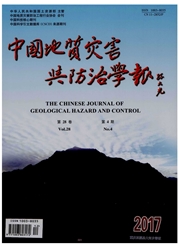

 中文摘要:
中文摘要:
泥石流是我国西南山区多发的地质灾害之一。本文从地质、地形、水文、植被及人类活动等自然和人为因素出发,运用GIS技术进行因子筛选,最终选取坡度、土壤侵蚀程度、大于50mm暴雨日数、土地利用方式、岩性、NDVI、到断层的距离及到沟谷的距离8个因子构建毕节地区泥石流危险性评价模型;并利用区域内93个历史泥石流灾害点对评价结果进行验证,结果显示87.1%的灾害点落在中度以上危险区域,模型适用于该地区泥石流危险性评价。通过泥石流危险性评价发现,毕节地区织金县、纳雍县、大方县南部大片区域危险性较高,赫章县中东部山地及毕节东北部大娄山附近次之,威宁自治县、赫章县西部与南部、大方县北部地区危险性相对较低。坡度、土壤侵蚀、岩性、断层分布等自然因素是泥石流发生的主要影响因素;人类活动导致的耕地分布与坡体不稳定性,也是泥石流的成因之一。
 英文摘要:
英文摘要:
Debris-flow is a frequent mountain hazard in southwest China, which is closely related to geology, topography, hydrology, vegetation and human activities. This paper chose eight factors based on GIS, namely, slope, soil erosion, average days with rainfall _-〉 50mm, land-use type, lithology, NDVI, the distance to fault and the distance to valleys, to establish the risk evaluation model. Analytic Hierarchy Process( AHP) is used to calculate the indices weights,. By the verification of 93 historical debris flow events, we find that this method is a good way to evaluate debris-flow risk. From this study,we find that the Zhijin county, Nayong county and south of Dafang county are in the highest risk; then follows the northeast of Hezhang county and Dalou mountain; Weining county, the southwest of Hezhang and the north of Dafang are in the least risk. Slope, soil erosion, lithology, fault distribution are the main natural factors of debris flow, while the slope instability caused by cultivated land are the main human factors.
 同期刊论文项目
同期刊论文项目
 同项目期刊论文
同项目期刊论文
 期刊信息
期刊信息
